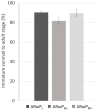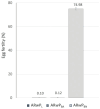Wolbachia Infection through Hybridization to Enhance an Incompatible Insect Technique-Based Suppression of Aedes albopictus in Eastern Spain
- PMID: 38535401
- PMCID: PMC10971076
- DOI: 10.3390/insects15030206
Wolbachia Infection through Hybridization to Enhance an Incompatible Insect Technique-Based Suppression of Aedes albopictus in Eastern Spain
Abstract
The emergence of insecticide resistance in arbovirus vectors is putting the focus on the development of new strategies for control. In this regard, the exploitation of Wolbachia endosymbionts is receiving increasing attention due to its demonstrated effectiveness in reducing the vectorial capacity of Aedes mosquitoes. Here, we describe the establishment of a naïve Wolbachia infection in a wild Aedes albopictus population of eastern Spain through a hybridization approach to obtain males capable of sterilizing wild females. The obtained lines were compared with the Wolbachia donor, Ae. albopictus ARwP, previously artificially infected with Wolbachia wPip, regarding immature and adult survival, female fecundity, egg fertility, and level of induced sterility. Our results did not show significant differences between lines in any of the biological parameters analyzed, indicating the full suitability of the hybrids to be used as a control tool against Ae. albopictus. In particular, hybrid males induced 99.9% sterility in the eggs of wild females without the need for any preliminary treatment. Being harmless to non-target organisms and the environment, the use of this bacterium for the control of Ae. albopictus deserves further exploration. This is especially relevant in areas such as eastern Spain, where this mosquito species has recently spread and may represent a serious threat due to its competence as a vector for dengue, chikungunya, and Zika viruses.
Keywords: Asian tiger mosquito; Wolbachia; arboviruses; cytoplasmic incompatibility; genetic control; genotyping; hybridization; population suppression.
Conflict of interest statement
The authors declare no conflicts of interest.
Figures





Similar articles
-
Exploiting Wolbachia as a Tool for Mosquito-Borne Disease Control: Pursuing Efficacy, Safety, and Sustainability.Pathogens. 2025 Mar 14;14(3):285. doi: 10.3390/pathogens14030285. Pathogens. 2025. PMID: 40137770 Free PMC article. Review.
-
Wolbachia strain wPip yields a pattern of cytoplasmic incompatibility enhancing a Wolbachia-based suppression strategy against the disease vector Aedes albopictus.Parasit Vectors. 2012 Nov 12;5:254. doi: 10.1186/1756-3305-5-254. Parasit Vectors. 2012. PMID: 23146564 Free PMC article.
-
Combining Wolbachia-induced sterility and virus protection to fight Aedes albopictus-borne viruses.PLoS Negl Trop Dis. 2018 Jul 18;12(7):e0006626. doi: 10.1371/journal.pntd.0006626. eCollection 2018 Jul. PLoS Negl Trop Dis. 2018. PMID: 30020933 Free PMC article.
-
Wolbachia density and cytoplasmic incompatibility in Aedes albopictus: concerns with using artificial Wolbachia infection as a vector suppression tool.PLoS One. 2015 Mar 26;10(3):e0121813. doi: 10.1371/journal.pone.0121813. eCollection 2015. PLoS One. 2015. PMID: 25812130 Free PMC article.
-
Critical review of the vector status of Aedes albopictus.Med Vet Entomol. 2004 Sep;18(3):215-27. doi: 10.1111/j.0269-283X.2004.00513.x. Med Vet Entomol. 2004. PMID: 15347388 Review.
Cited by
-
Exploiting Wolbachia as a Tool for Mosquito-Borne Disease Control: Pursuing Efficacy, Safety, and Sustainability.Pathogens. 2025 Mar 14;14(3):285. doi: 10.3390/pathogens14030285. Pathogens. 2025. PMID: 40137770 Free PMC article. Review.
-
Strengthening resilience to emerging vector-borne diseases in Europe: lessons learnt from countries facing endemic transmission.Lancet Reg Health Eur. 2025 Apr 4;53:101271. doi: 10.1016/j.lanepe.2025.101271. eCollection 2025 Jun. Lancet Reg Health Eur. 2025. PMID: 40247854 Free PMC article. Review.
References
-
- WHO (World Health Organization) Global Vector Control Response 2017–2030. World Health Organization; Geneva, Switzerland: 2017. [(accessed on 1 March 2024)]. Licence: CC BY-NC-SA 3.0 IGO. Available online: http://www.jstor.org/stable/resrep35629.
-
- Tozan Y., Branch O.L.H., Rocklöv J. Vector-borne diseases in a changing climate and world. In: Pinkerton K.E., Rom W.N., editors. Climate Change and Global Public Health. Humana; Cham, Switzerland: Totowa, NJ, USA: 2021. pp. 253–271. Respiratory Medicine.
-
- Roiz D., Wilson A.L., Scott T.W., Fonseca D.M., Jourdain F., Müller P., Velayudhan R., Corbel V. Integrated Aedes management for the control of Aedes-borne diseases. PLoS Negl. Trop. Dis. 2018;12:e0006845. doi: 10.1371/journal.pntd.0010310. Erratum in PLoS Negl. Trop. Dis. 2022, 16, e0010310. - DOI - PMC - PubMed
-
- WHO (World Health Organization) Global Vector Control Response: Progress in Planning and Implementation. World Health Organization; Geneva, Switzerland: 2020. [(accessed on 1 March 2024)]. Licence: CC BY-NC-SA 3.0 IGO. Available online: https://www.who.int/publications/i/item/9789240007987.
LinkOut - more resources
Full Text Sources

